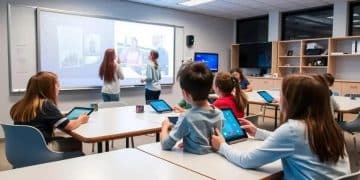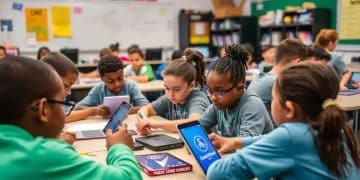Insights on vr learning environments changing education
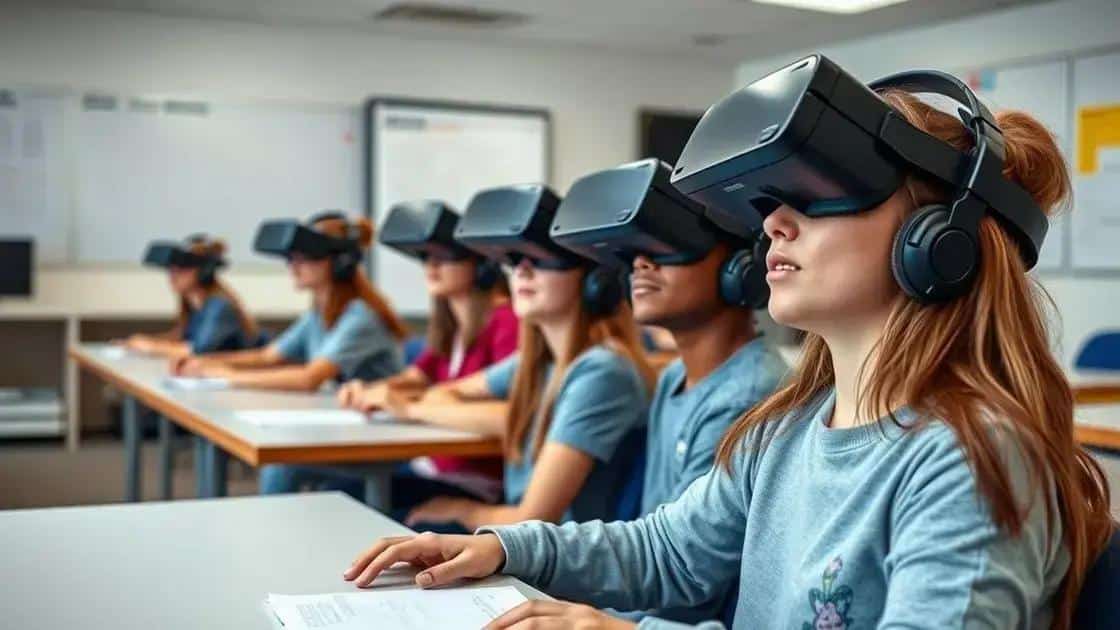
Insights on VR learning environments show that they enhance student engagement, increase accessibility, and foster personalized learning experiences while addressing challenges such as cost and technology integration.
Insights on vr learning environments are reshaping education as we know it. Have you ever wondered how virtual reality can create immersive learning experiences? Let’s dive into the exciting developments in this field.
Understanding the concept of VR learning environments
Understanding VR learning environments is essential in today’s educational landscape. These spaces utilize virtual reality technology to create engaging and immersive experiences for students. By simulating real-world situations and environments, educators can enhance the learning process significantly.
What are VR Learning Environments?
VR learning environments are interactive settings that allow students to explore and learn through virtual simulations. This approach can recreate anything from historical events to complex scientific processes. Students can gain practical experience without the risks associated with real-life scenarios.
Key Benefits of VR Learning
- Increased Engagement: Students are more likely to be interested and involved.
- Enhanced Retention: Interactive experiences help students remember concepts better.
- Safe Learning: Students can practice skills without real-world consequences.
- Diverse Learning Styles: Accommodates various ways students learn and interact.
This innovative method not only makes learning fun but also supports different learning styles, allowing for a more inclusive educational experience. For example, visual learners can benefit from simulations, while kinesthetic learners can engage in hands-on activities within the virtual environment.
As technology continues to evolve, the potential for VR in learning grows. Imagine exploring Mars as part of a science lesson or walking through ancient Rome in a history class. These are just glimpses of what VR learning environments can offer.
Real-World Applications
Educational institutions are already implementing VR in various fields:
- Medical Training: Future doctors practice surgeries in a risk-free setting.
- Architecture: Students design and walk through virtual buildings before they are built.
- History Lessons: Students experience historical events as if they were actually there.
As we further understand the benefits and applications of VR learning environments, it’s clear they have the potential to transform education. By harnessing this technology, educators can prepare students for a rapidly changing world, where adaptability and immersive experiences will be key to success.
The impact of VR on student engagement
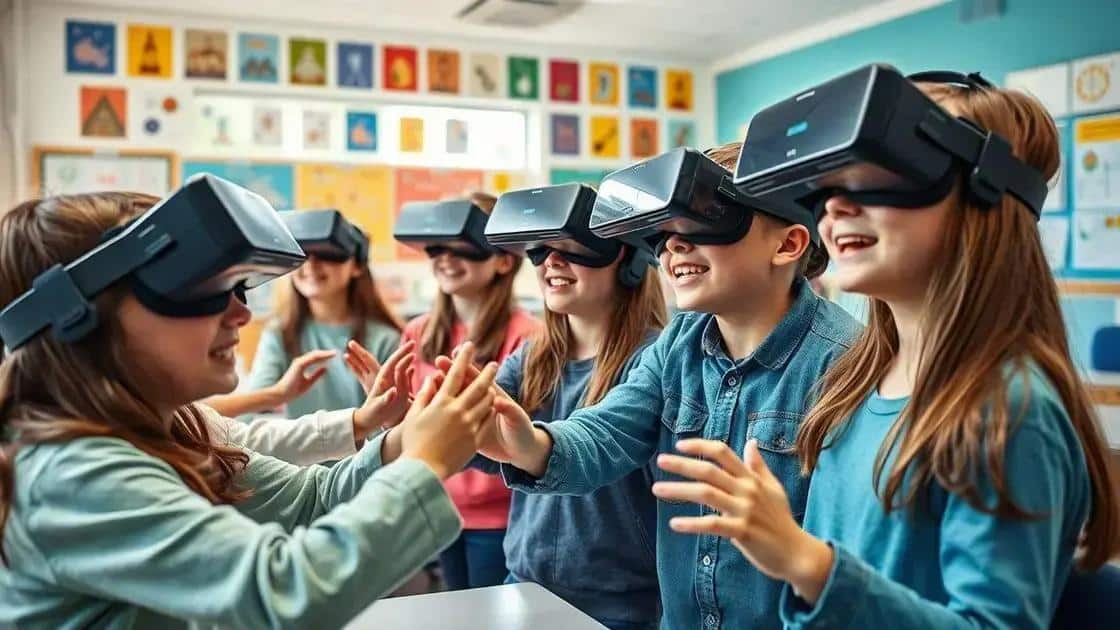
The impact of VR on student engagement is profound and multifaceted. By immersing students in interactive experiences, virtual reality captures their attention and stimulates their interest in learning.
How VR Increases Engagement
When students use VR, they are not just passive recipients of knowledge. Instead, they actively participate in their learning journey. Studies have shown that VR technology can enhance focus and retention. Students often report feeling more present and connected to the material.
- Active Participation: Students learn by doing, which keeps them engaged.
- Immersive Experiences: Realistic scenarios make learning memorable.
- Instant Feedback: Students receive immediate results, boosting motivation.
- Collaboration Opportunities: VR can facilitate teamwork, enhancing engagement.
Many educators have noticed that when students are involved in VR learning environments, they become more engaged in class discussions. For instance, after exploring a historical event through VR, students are often eager to share their insights and perspectives.
Fostering Curiosity
VR goes beyond traditional methods by sparking curiosity. Students are often eager to explore topics that interest them. By simulating environments like outer space or under the sea, VR opens up new worlds for exploration.
This heightened curiosity leads to deeper learning. As students encounter various scenarios, they may ask questions and seek answers. This inquiry-based approach fosters a love for learning that lasts beyond the classroom.
Educators can leverage VR to create experiences that encourage exploration and experimentation. When students feel excited about learning, their engagement naturally increases.
The Role of Gamification
Integrating gamification into VR learning environments further enhances student engagement. Game elements, such as points or achievements, motivate students to participate actively. They can work to complete challenges and gain rewards that recognize their efforts.
- Competition: Friendly competition can drive engagement.
- Achievements: Badges or certificates motivate students to excel.
- Challenges: Tasks that increase in difficulty keep students focused.
Through these engaging methods, VR transforms education into an interactive and exciting experience that captivates students and promotes a lifelong passion for learning.
Challenges in implementing VR learning
Challenges in implementing VR learning can impact the effectiveness of this innovative technology in education. While virtual reality offers exciting opportunities, several barriers must be addressed.
Costs and Budget Constraints
One significant challenge is the cost of VR technology. Schools may struggle to allocate funds for VR headsets, software, and maintenance. Often, educational institutions have limited budgets. This can hinder the adoption of VR learning environments.
- Equipment Costs: High initial investments for VR hardware.
- Software Licenses: Ongoing expenses for specialized learning programs.
- Training Costs: Resources needed for teacher training and implementation.
Such financial issues can delay or prevent integration, leaving schools unable to provide immersive learning experiences.
Technical Issues
Another challenge is the technology itself. VR systems can be complex and may require robust infrastructure. Technical difficulties can frustrate educators and students alike. For example, internet connectivity issues can disrupt sessions, making it hard to maintain the flow of VR learning.
Moreover, regular updates and maintenance are crucial to keeping VR systems running smoothly. Educators might not have the necessary tech support readily available. This can lead to downtime or skepticism about the value of VR investment.
Curriculum Integration
Integrating VR into existing curricula can be challenging. Teachers must learn how to incorporate VR lessons effectively. Additionally, the content provided by many VR programs may not align with specific educational standards or learning objectives.
- Time Constraints: Teachers must find time to learn and implement new technology.
- Curriculum Compatibility: VR content may not match what is taught.
- Teacher Training: Not all educators feel comfortable with tech tools.
Training teachers to use VR learning environments is essential, but it requires time and resources that may not be available.
Student Readiness
Finally, student readiness can pose a challenge. While many students are tech-savvy, not all may have experience with VR technology. Some may feel disoriented or overwhelmed. Ensuring students are comfortable navigating VR spaces is essential for effective learning.
As students become familiar with this technology, their confidence will grow. Providing orientation sessions before full-scale implementation can help ease this transition.
Future trends in VR educational technology
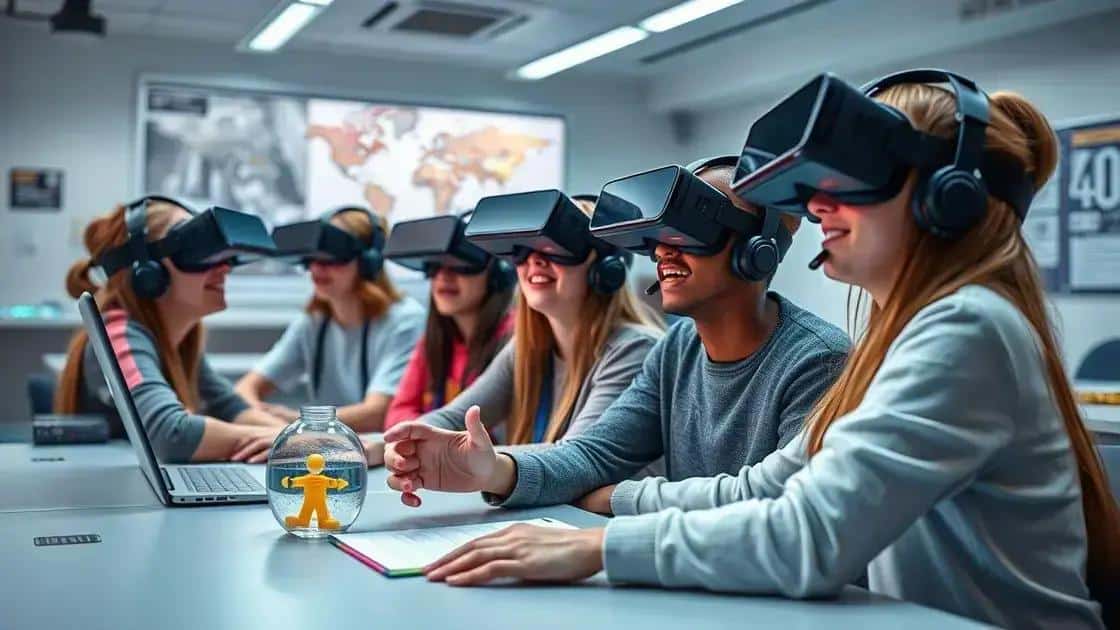
Future trends in VR educational technology show great promise for transforming the learning experience. As technology advances, educators and students can expect even more engaging and immersive learning environments.
Increased Accessibility
One major trend is the increased accessibility of VR technology. As costs decrease and more schools adopt VR tools, a wider range of students will be able to participate in these experiences. This will allow educators to reach diverse learning populations.
- Affordable Devices: New partnerships with tech companies may lead to lower costs for headsets.
- Cloud VR: Hosting VR experiences in the cloud can reduce hardware needs in schools.
- Mobile VR: Using smartphones in VR will make technology more accessible to students everywhere.
With greater accessibility, VR in education could become a standard tool used in classrooms, making learning more inclusive.
Integration of Artificial Intelligence
Another exciting trend is the integration of artificial intelligence (AI) with VR technology. AI can enhance personalization and adapt learning experiences to individual student needs. Imagine a VR program that adjusts difficulty based on how well a student performs.
- Personalized Learning: AI can tailor experiences to students’ skill levels.
- Real-time Feedback: Instant assessments can help teachers adjust lessons accordingly.
- Adaptive Learning Paths: Students may follow unique learning journeys suited to their interests.
This combination of AI and VR could provide deeply personalized education that engages students on multiple levels.
Collaboration and Social Learning
Future VR platforms may also focus on enhancing collaboration among students. Virtual spaces can allow groups to work together in real-time, no matter their physical locations. Students can solve problems, conduct experiments, or create projects in shared VR environments.
Incorporating social interactions in VR learning environments can make education feel more connected and alive. As they collaborate, students strengthen their communication and teamwork skills.
Expansion of Subject Areas
Lastly, we can expect a growing variety of subjects to be taught using VR technology. From STEM to the arts, the potential for immersive learning experiences spans numerous educational fields.
For example, students can virtually explore historical sites in a history class or perform virtual experiments in a science lab. This not only makes learning fun but deepens understanding of complex concepts through visualization and interaction.
As VR educational technology continues to evolve, these trends will likely shape the way students learn, making education more engaging, personalized, and collaborative than ever before.
FAQ – Frequently Asked Questions About VR Learning Environments
How can VR technology improve student engagement?
VR technology immerses students in interactive learning experiences, making education more engaging and effective.
What are some challenges in implementing VR learning?
Challenges include high costs, technical issues, curriculum integration, and ensuring student readiness for VR experiences.
What future trends can we expect in VR education?
Future trends include increased accessibility, integration of AI for personalization, enhanced collaboration, and expansion of subjects taught using VR.
How does AI integrate with VR in education?
AI enhances VR by personalizing learning experiences, providing real-time feedback, and adapting content to match student needs.



